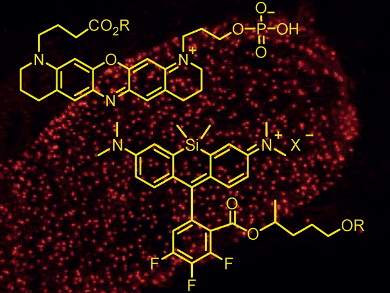Far-red emitting dyes are widely used in life sciences as fluorescent markers, as red light is noninvasive and provides good tissue penetration depth. In this respect it is also important that a variety of inexpensive, convenient, and powerful commercial lasers are available for this optical region, for example, stimulated emission depletion (STED) microscopy.
Nobel Prize winner Stefan W. Hell, Max Planck Institute for Biophysical Chemistry, Göttingen, Germany, who pioneered the technique of STED microscopy, as well as Kirill Kolmakov and Vladimir N. Belov are interested in developing new near-IR dyes, such as fluorinated silicon–rhodamine dyes (SiRF dyes) and phosphorylated oxazines, as well as improving the performance of the STED methodology.
With regard to SiRF dyes, they have found a high-yielding synthetic path to introduce three aromatic fluorine atoms and unconventional conjugation/solubilization spacers into the scaffold of SiRF dyes. By using a wavelength of 800 nm for the STED beam instead of the commonly used 750–775 nm, they were able to obtain an excellent imaging performance and suppresses re-excitation of SiRF and the oxazine dyes.
The use of such a red-shifted laser is important for biological applications as it could lead to a reduction in photodamage, protein autofluorescence, and light scattering, while achieving deeper light penetration.
- Far-Red Emitting Fluorescent Dyes for Optical Nanoscopy: Fluorinated Silicon-Rhodamines (SiRF Dyes) and Phosphorylated Oxazines,
Kirill Kolmakov, Elke Hebisch, Thomas Wolfram, Lars A. Nordwig, Christian A. Wurm, Haisen Ta, Volker Westphal, Vladimir N. Belov, Stefan W. Hell,
Chem. Eur. J. 2015.
DOI: 10.1002/chem.201501394



